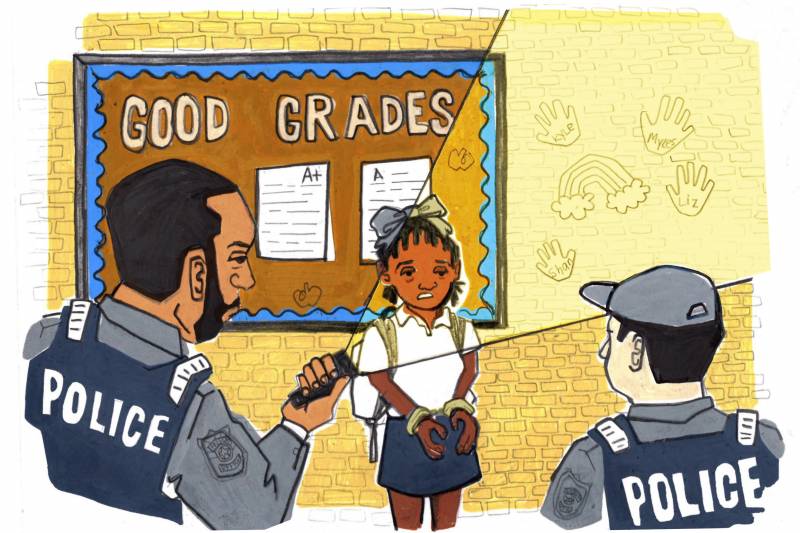He points to two separate incidents captured on body cameras in the fall semester of 2019. One officer in Florida put a 6-year-old girl in handcuffs as she sobbed. Another in New Mexico was shown shoving an 11-year-old girl against a wall. Both students were Black.
"And what is happening in schools around the country," says Hagopian, "is, instead of figuring out how to help that [student] who's having a difficult time by having counselors, we meet these kids with force."
This all adds up to what Monique Morris calls the criminalization of Black students.
"The presence of police in schools, I believe, is fueled by a dehumanization of children of color, which suggests that there needs to be a constant surveillance of these children in schools."
Morris is the author of the books Pushout and Sing A Rhythm, Dance a Blues about Black girls' educational experiences. She says new research shows that police in majority white and affluent schools are more likely to think of their job as protecting the school from outside threats, such as shootings. But in schools that were lower-income and majority students of color, they are instead looking at the students themselves as threats.
"For children of color, we see that this leads to a hyper-criminalization and a way that people perceive them to be criminal, even if they are just being children," Morris explains.
School resource officer programs began in the 1950s in Flint, Mich., as a form of community policing and to strengthen ties between young people and police, says Mo Canady of the National Association of School Resource Officers. They grew quickly starting in the 1990s amid fear about school shootings. The U.S. Department of Justice has funded these programs to the tune of tens of millions of dollars, expanding its support after the Parkland, Fla., school shooting in 2018.
Federal data analyzed by the American Civil Liberties Union shows millions of students, especially students of color, attend schools that have police officers, but no nurse or school psychologist.
In the past, parents have largely supported the presence of armed officers in schools, and until recently so have teacher unions. That changed on June 18, when the American Federation of Teachers, one of the country's largest teacher unions, passed a resolution calling for the separation of school safety and policing.
"There isn't much evidence indicating that police officers in schools make schools safer," says Dominique Parris of the research organization Child Trends. "What they do do is increase the likelihood that Black and brown children are going to be involved in the legal system early and often."
There are dozens of documented incidents in the past decade where a resource officer tasered, pepper sprayed, injured or otherwise used force on a student.
Mo Canady of NASRO argues this is a problem of training. When properly trained by his organization, he says SROs can prevent violence and juvenile arrests while building positive relationships. "When these relationships are built the way they should be, then we wind up with students sharing information with SROs. We wind up with parents of students sharing information. And sometimes that information helps us to stop a potential act of violence before it ever, ever occurs."
A 2018 Washington Post analysis of nearly 200 incidents of gun violence on campus found only two times where a school resource officer successfully intervened in a shooting. Canady says there are many more. "In several ... incidents SROs responded and stopped the shootings before more lives were lost. In some cases, they stopped the shooting before any lives were lost."
He cites as a success story a 2018 incident in Maryland where a high school student killed an ex-girlfriend, injured another boy and then shot himself fatally as he was fired on by an SRO.
Still, research doesn't definitively show SROs are effective at improving school safety. The good news, say Morris and Parris, is that there are evidence-based alternatives. These include restorative justice programs, a program called Positive Behavioral Interventions and Supports, and having mental health counselors and other support staff available when students are acting out.
"If there is conflict, rather than calling in law enforcement, [the student] can take a breath and go into meditation or they can watch a video and learn how to reset their emotions," says Morris.
Research by the U.S. Secret Service shows these interventions — designed to build trust between students and adults — can also prevent gun violence and mass shootings by making "bystander" students more likely to speak up if a classmate is making threats to others, or is suicidal.
Morris says these alternative strategies can make schools safer and more welcoming for all students, without police.
Copyright 2020 NPR. To see more, visit https://www.npr.org.
9(MDAxOTAwOTE4MDEyMTkxMDAzNjczZDljZA004))



9(MDAxOTAwOTE4MDEyMTkxMDAzNjczZDljZA004))